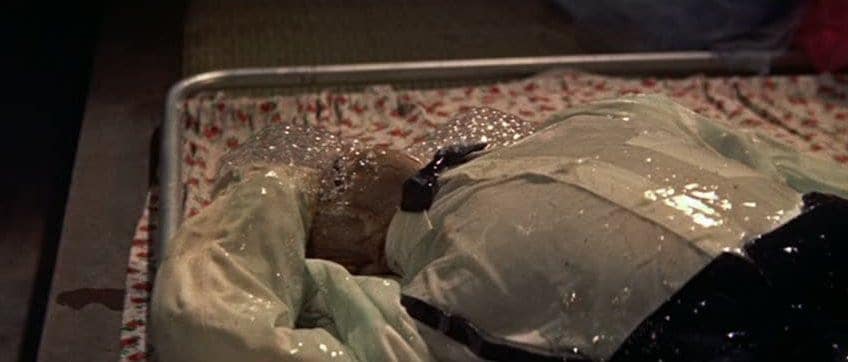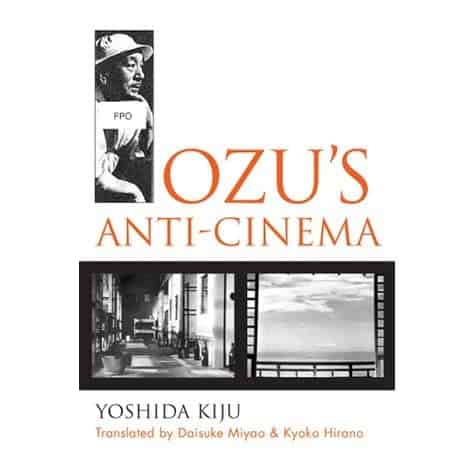Just several years prior, Toho Studios and director Ishiro Honda scored critical and audience success with the monumental Gojira/Godzilla, unleashing a cavalcade of projects that inspired countless kids and filmmakers for generations to come. One of the more overlooked and underrated efforts to come from their cooperation was a rather simple concoction of film-noir, sci-fi and horror originally written off as a Blob rip-off but has become more beloved over time as more have given a look at his classic Bijo to Ekitai-Ningen, also known as “The H-Man”.
Buy This Title
After a strange accident, Inspector Tominaga (Akihiro Hirata, from “Gojira”) is called to investigate the case which shows a gangster mysteriously vanishing on city streets with just his clothes, gun and a bag of narcotics left behind. Finding the man's girlfriend Chikako (Yumi Shirakawa, from “Rodan”) a night-club singer at a club that operates as a front for the gang, involved with the strange disappearances, they question her but manage to come up empty in their quest to understand what's going on. Eventually, Dr. Masada (Kenji Sahara, from “Mothra vs. Godzilla”) comes forward with a claim about radioactive killers living in the sewer under the city who reduce their victims to liquid, running wild on the gang and forcing them to band together to stop the creatures and save her.
Overall, this was a rather enjoyable genre-effort. One of ‘The H-Man's' best aspects is the rather ingenious manner Takeshi Kimura's screenplay weaves together several seemingly random plot points into a cohesive setup. The classic setup here is a full-on, film-noir style story, complete with the focus on the gangsters, the girlfriend who gets dragged into the proceedings against her wishes and the hard-boiled cops on their trail evoke those classic gangster dramas of the past. There is a general sense of evil pervading every corner of the environment, with the rain-slickened streets, somber atmosphere and stark police interrogations of the criminal organization members. These scenes are emblematic of the style of film presented here.

From this basic framework comes the rather fun horror elements of the story. Dr. Tominaga's theory about the radioactive poisoning affecting the sailors on the ship offers up a perfectly logical point to bring about the appearance of the murderous blob of killers that slowly is brought up. Their introduction into the story, basically hunting down the criminal gang in the rain-drenched streets on the outskirts of the police investigation into their activities, is rather chilling. The overall concept, men irradiated by exposure to radiation and turned into shapeshifting killers, serves the film well enough as the origins of the creature, while the overall look of the strange beings in either liquid glop or gaseous humanoid forms leaves an incredible impression.
This fine setup is perfectly exploited by the action scenes within here. The mix of horror and action is rather enjoyable, including the incredibly creepy and chilling set piece on the boat where the fishermen recall the experience of finding the deserted ship covered in nothing but clothes, which includes claustrophobic shots of the ships' interiors. The eeriness of the ghost ship, enhanced by the dark atmosphere and effective cinematography of Hajime Koizumi, brings out the look of a true ghost-ship. That setting provides the perfect launching point for the various attacks on the crew members where they are shown dissolving into liquid in a matter of seconds in shocking sequences courtesy of Eiji Tsuburaya's spectacular special effects.

The other big action scenes here are just as much fun. The nightclub ambush, full of the various gangsters concocting their plans and officers interacting with the different gang-members in the midst of their plans while the blobs appear to strike, leads onto the series of dissolving of the various policemen or gangsters it comes into contact with, all of which are presented against the blaring jazzy music composed by Masaru Sato, making for a fun sequence. Leading into the stylistic finale in the sewers where the final confrontation is held with the creatures amidst the flames of the authority's plans to stop them, these big scenes are more than enough to hold it up over its few flaws. This one is really only hurt by the rather unquestionably out-of-place story line involving the inability to recognize the creatures' existence since it takes two or three visits to the police to get them to believe the truth which doesn't really serve any point here. However, it's really the main issue here.
With plenty of highly enjoyable elements scattered throughout the film, it has enough going for it that those minor issues aren't even worthwhile enough to hold it back. Recommended viewing for any fan of these types of genre entries or other aficionados of the studios' fare, while those that aren't into the dated genre entries should heed caution here.
















